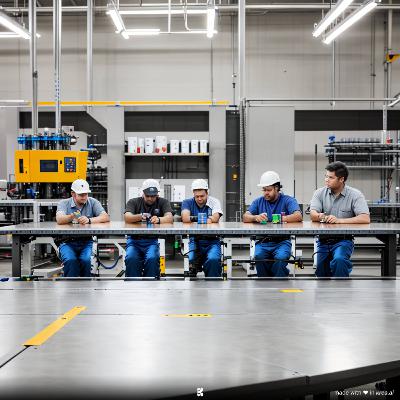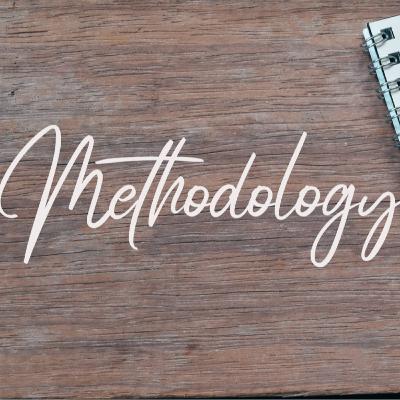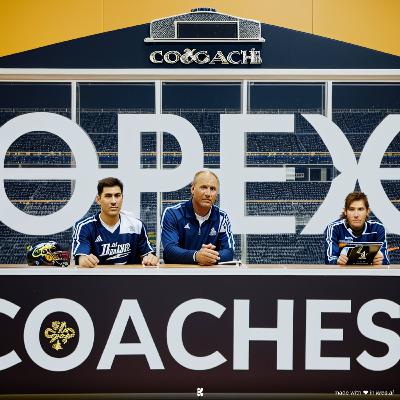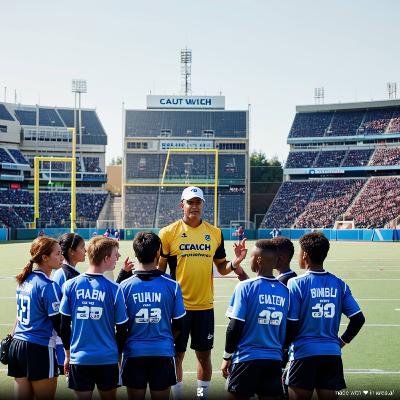Discover The Operational Excellence Journey to Artificial Intelligence Consulting
The Operational Excellence Journey to Artificial Intelligence Consulting

The Operational Excellence Journey to Artificial Intelligence Consulting
Author: Belt Course
Subscribed: 1Played: 0Subscribe
Share
Description
This podcast provides lessons learned from Industrial and Supply Chain organizations in their Operational Excellence (Lean, TPM/WCM, Six Sigma) journey, to help professionals advance in their own career journey to become an Artificial Intelligence Consultant.
30 Episodes
Reverse
Read the blog article here: https://www.beltcourse.com/blog/linkedin-growth-that-lands-ai-opex-ci-clients-without-gaming-the-algorithm A detailed guide for Artificial Intelligence (AI), Operational Excellence (OpEx), and Continuous Improvement (CI) consultants on leveraging LinkedIn for client acquisition. It outlines a strategic playbook for creating content that resonates with B2B buyers, emphasizing observable signals for distribution rather than trying to outsmart the algorithm. Key areas covered include optimizing post engagement, crafting impactful content formats, and using LinkedIn's native features to maximize reach. The guide also offers practical advice on posting frequency, avoiding common mistakes, and measuring success through relevant metrics, aiming to help consultants generate qualified leads and conversations.
This episode explores the evolving landscape of continuous improvement leadership and identifies significant skill deficiencies across various sectors. It highlights universal gaps in areas like digital transformation leadership and data analytics, while also detailing industry-specific needs for Industrial Advanced (e.g., automotive, medical devices), Industrial (e.g., pharmaceuticals, food & beverage), and Supply Chain professionals. The analysis proposes tailored coaching programs designed to address these gaps, emphasizing technical, leadership, and strategic competencies.
Coaching Programs for Industrial Advanced
Digital Transformation: Transition to lead a Digital and Artificial Intelligence Transformation from start to finish! Click here to learn more.
DMAIC and AI-Assisted Process Improvement: Master the DMAIC methodology and AI-enhanced analytics to become the go-to process improvement leader! Click here to learn more.
Innovation Launch Mastery: Master FMEA, Digital Twins, and Agile Innovation to become the launch leader who delivers on time, on budget, and exceeds expectations! Click here to learn more.
Coaching Programs for Industrial
Achieving Stability (Focus on Stability and Sustainment): Solidify your teams' ability to sustain improvements with the use of control plans, proper communication, report-outs, Layered Audits, and more! Click here to learn more.
A3 Problem-Solving (RCA, First Projects in your A3): lead projects, using A3 Problem-Solving and Job-Specific pathways dependent on your opportunities! Click here to learn more.
Lean Leader: Start using Lean methodologies and tools (VSM, 5S, QCO, TPM, DMS, Kaizen, JIT, Poke Yoke, etc.) to transform your value streams. Click here to learn more.
Kaizen Leader: Be fully prepared to lead a Kaizen Event to make sustainable improvements quickly, without wasted efforts! Click here to learn more.
Coaching Programs for Supply Chain
Digital Transformation: Transition to lead a Digital and Artificial Intelligence Transformation from start to finish! Click here to learn more.
Supply Chain Management (SCM) Leader: Achieve stability and advance into Proactive Supply Chain Management This Year! Click here to learn more.
Strategic Planning (Hoshin Kanri + Value Stream Mapping, Bottleneck, OEE & Loss Analysis): Build your Strategic Plans, aligning goals with resources, without taking years to get better at it! Click here to learn more.
Read the source article here: https://www.beltcourse.com/blog/the-ci-manager-crisis-why-ci-leaders-struggle-and-why-hiring-a-ci-manager-from-outside-isn-t-the-solution
Continuous Improvement (CI) Managers frequently struggle due to issues like team resistance, role ambiguity, and a lack of impact. The author contends that hiring externally is a detrimental solution because it leads to slow ramp-up times, higher costs, and internal team demoralization. Instead, the article advocates for developing internal talent to fill CI Manager roles, emphasizing that individuals already familiar with the organization's culture and processes are better positioned for success. This internal development approach fosters quicker integration and boosts overall team morale and retention, ultimately leading to more effective and sustainable CI initiatives.
Read the article that was the source of this discussion here: https://www.beltcourse.com/blog/why-do-operational-excellence-implementations-fail-in-2024
Learn a better way at www.beltcourse.com
This episode explores why Operational Excellence (OpEx) implementations often fail, identifying a primary issue as a lack of comprehensive capability building rather than solely blaming leadership. It acknowledges the challenges faced by OpEx professionals in providing sufficient training to everyone and examines existing solutions like consultants and outside training providers, highlighting their limitations in cost, practicality, and scope. The author suggests a need for different solutions that leverage the expertise of multiple individuals and provide a structured roadmap for training the right people effectively, with the goal of significantly reducing OpEx failure rates.
For a longer list of specific easy and impactful office project examples for each of the most common areas and functions, find it by clicking here!
Office & Service Companies – 10 Project Ideas per area
Office Functions within Industrial Organizations – 10 Project Ideas per function
The application of Lean in Offices and Service environments is slightly different... learn more about it here... https://www.beltcourse.com/lean-in-offices-and-services-one-pager
This episode explores numerous project ideas for applying Lean methodologies, Operational Excellence principles, and Artificial Intelligence within office and service environments. It categorizes these examples into ten distinct areas for both office and service companies, such as legal, accounting, and marketing, and ten specific office functions within industrial organizations, including engineering, finance, and HR. For each area and function, targeted project concepts are discussed, offering concrete starting points for continuous improvement initiatives. Many examples explicitly mention specific tools like A3 problem-solving, value stream mapping, FMEA, and potential AI applications like automation and prediction. The episode aims to inspire practical application of these concepts for enhancing efficiency and effectiveness in various organizational settings.
Lean and Operational Excellence (OpEx) methodologies, traditionally associated with manufacturing, are highly applicable and beneficial in office and service environments. These principles address common workplace inefficiencies such as lengthy approval processes and redundant tasks by treating offices as "invisible factories" with improvable workflows. By employing tools like process mapping, root cause analysis, and AI-powered insights, organizations can reduce errors, eliminate low-value work, and empower employees.
You have to equips teams with practical skills to implement these improvements, offering real-world examples of successful transformations across various industries. Ultimately, applying Lean and OpEx, often enhanced by AI, leads to significant gains in efficiency, customer satisfaction, and overall organizational performance in non-manufacturing settings.
Join the Office Operational Excellence Program today.
✔️ Explore the Program📄 Download the Full Program Outline
Lean isn’t just for factories anymore—let’s bring it to the office, where it belongs.
The application of Lean in Offices and Service environments is slightly different... learn more about it here... https://www.beltcourse.com/lean-in-offices-and-services-one-pager
For a longer list of specific easy and impactful office project examples for each of the most common areas and functions, find it by clicking here!
Office & Service Companies – 10 Project Ideas per area
Office Functions within Industrial Organizations – 10 Project Ideas per function
Get coached by our AI Assistant OpEx Coach! Link: https://www.beltcourse.com/opex-coaches-ai-assistant
Get your Kaizen Event Planning Checklist here:
https://www.beltcourse.com/opt-in-66aea8d5-aee0-44d8-9b07-95328d6f098a
Get your Kaizen Event agenda template here:
https://www.beltcourse.com/kaizen-event-agenda-template
This episode explains kaizen events by providing various industry-specific examples that illustrate their application in solving different operational problems. Organized by sector like manufacturing, food production, and even airports, each example outlines a problem statement, the steps taken during a kaizen event, and the resulting improvements. The purpose is to inspire readers with relatable scenarios and highlight the versatility of kaizen for continuous improvement. Additionally, the text includes links to further resources and training opportunities.
Blog article here - Kaizen and AI Project Examples in Office and Service Environments.
https://www.beltcourse.com/blog/examples-of-kaizen-events-for-different-types-of-problems
This episode compares various Operational Excellence (OpEx) methodologies, including Six Sigma, Lean, Theory of Constraints, Total Productive Maintenance, World Class Manufacturing, and Agile. It explores reasons for OpEx program failures, emphasizing the importance of integration, culture change, and employee involvement. It highlights the benefits of combining methodologies.
If you'd like to see a chart that outlines the industries, famous companies, key performance indicators (KPIs), strengths, and weaknesses associated with each methodology. check it out here:
You can also look into Belt Course's coaching programs that combine the best of all OpEx methodologies and provides opportunities to become a coach or consulting partner. Learn more at www.beltcourse.com.
Digital transformations often fail due to internal organizational behaviors and psychological factors. Common themes in failed transformations include unrealistic expectations, internal misalignment, and resistance to change. Organizations often lack a clear vision of their future state and over-delegate responsibilities to project teams or technical implementers.
Effective program management and governance are crucial, as is the ability to recognize and mitigate risks early on. Success requires a balanced approach, building internal competencies while leveraging external expertise.
Does it sound a lot like Lean and Operational Excellence Transformations? Maybe these transformations need to be integrated for success, learning from previous failures and building on the strengths of each pathway.
Are you a Tech Industry professional working on transitioning to a role in Industrial or Supply Chain organizations? Or an Industrial Organization leader wishing to advance into a digital transformation?
This program in any language will help you transition to lead a Digital Transformation from start to finish!
Link: https://www.beltcourse.com/digital-transformation-program
Assess your OpEx Champion & Sponsor skills here!
https://www.beltcourse.com/opex-champion-sponsor-skills-assessment-access
Get your own customizable OpEx Deployment A3 here:
https://www.beltcourse.com/opt-in-06eaf5f1-6189-499e-990a-12a31f011fb1
The episode discusses the crucial role and function of steering committees within organizational improvement initiatives in the context of lean transformations, highlighting their importance in providing leadership alignment and guidance to lean facilitators. Their responsibilities include strategic decision-making, resolving escalated issues, and ensuring projects stay on track with resources and budget. World Class Manufacturing (WCM), a comprehensive methodology for achieving operational excellence through managerial and technical pillars, requiring top management involvement and continuous improvement efforts.
Learn more about WCM in this blog article that gathers the best resources in one place.
What is WCM (World Class Manufacturing) - Pillars and Structure Overview. Link: https://www.beltcourse.com/blog/world-class-manufacturing-wcm-explained-in-detail
World Class Manufacturing (WCM) is a comprehensive methodology that integrates Lean principles, Total Productive Maintenance, and Total Quality Management to foster continuous improvement and eliminate waste. It features 10 managerial and 10 technical pillars, each with steps for reactive, preventive, and proactive phases, offering a structured approach to operational excellence adaptable across industries. Successful implementation requires top management commitment, a clearly defined plan, and continuous employee development. WCM emphasizes waste elimination, efficiency, quality improvements, cost savings, and sustainable practices, undergoing regular audits to assess its effectiveness. Customization is encouraged to align with specific organizational structures, facilitated by dedicated teams with leaders experienced in their respective areas. The goal is to drive cultural change, making WCM an integral part of every employee's role, as supported by resources and training programs.
This episode explores the JIPM TPM Award, which recognizes excellence in Total Productive Maintenance, emphasizing structured pillars and lean tools. It highlights its comprehensive structure that uses checklists and pillars. The piece details the award process, benefits such as growth and cost reduction. However, it also critiques the award's shortcomings, such as a "checklist" mentality that may misdirect resources and its failure to evolve with modern business trends like Digital Transformation. The article suggests companies should evolve TPM instead of rigidly pursuing an outdated award system, referencing World Class Manufacturing as an attempt at modernization.
The affiliative leadership style, emphasizing harmony and strong relationships within a team. It defines the style's core elements, such as a people-first approach, strong morals, and positive communication. The video details the advantages of this style, including improved morale and conflict resolution, while also addressing its weaknesses, like overlooked underperformance and avoidance of constructive criticism. It emphasizes the importance of using this style in conjunction with others, and offers advice on implementing affiliative techniques while mitigating potential negative outcomes. The overall goal is to guide leaders in fostering positive team environments while still achieving organizational objectives.
Course Forward:
Consider sharing with others to understand why TPM is more comprehensive than just Maintenance, just at one Site, or just in Operations.
And if you'd like to learn more about TPM or WCM (WCM is an evolution of TPM which attempts to modernize TPM and add other managerial pillars and technical pillars which were a gap in TPM), please visit our blog sections...
TPM: https://www.beltcourse.com/blog?tag=total+productive+maintenance
WCM: Note there will be a lot of overlapping articles, but that will help you also see the similarities and differences between TPM and WCM. https://www.beltcourse.com/blog?tag=total+productive+maintenance
TPM aims to maximize equipment effectiveness through comprehensive employee involvement. It seeks to transform the mindset from reactive repairs to proactive care, treating equipment as if it were brand new. This involves teamwork, skill development, and a focus on machine stability and availability. TPM strives for zero breakdowns and losses through strategies like autonomous maintenance and planned maintenance. The system focuses on addressing hidden defects and fostering a healthier company culture by prioritizing equipment health, comparing it to personal health. TPM implementation includes eight key strategies with a focus on the reality of broken machines. The approach encourages an aspirational zero-tolerance for breakdowns, similar to safety and quality goals.
Join Belt Course as a Coach here: https://www.beltcourse.com/join-us-as-a-coach
And consider becoming a Partner here: https://www.beltcourse.com/becomeapartner
Check out Belt Course's Simulation Calendar here: https://www.beltcourse.com/simulations-calendar
Guidance on pursuing a career in Continuous Improvement (CI) consulting. It explores the role of a CI consultant, emphasizing the need to guide clients through improvement processes using appropriate tools. The speaker outlines two primary paths: joining a consulting agency directly or gaining experience through a corporate CI team. The video highlights the pros and cons of each route: agencies offer broader exposure and structured learning but may prioritize sales, while corporate roles provide in-depth experience within a single organization, but can result in a limited understanding of the discipline. The video stresses the importance of analytical skills, change management, and practical implementation expertise for success in the field, and stresses the importance of making change happen by also taking the people involved along the CI journey.
On this episode, we explore why and how the Visionary Leadership style (one of Goleman's 6 Leadership Styles based on Emotional Intelligence) can be used in an Operational Excellence setting. Whether it's in a turnaround, a startup, or Hoshin Kanri, you'll learn about its benefits and limitations.
To learn more about Leadership in an Operational Excellence setting, visit our blog at https://www.beltcourse.com/blog?tag=leadership
This episode explores commanding leadership, a style where the leader makes all decisions and enforces strict control. The hosts discuss its effectiveness (particularly in low-complexity tasks and less-skilled teams) and drawbacks (reduced employee engagement and stifled creativity) in an Operational Excellence setting.
Join Belt Course as a Coach here: https://www.beltcourse.com/join-us-as-a-coach
And consider becoming a Partner here: https://www.beltcourse.com/becomeapartner
Check out Belt Course's Simulation Calendar here: https://www.beltcourse.com/simulations-calendar
An Operational Excellence Consultant can grow their business by partnering with Belt Course to gain access to their simulation-based programs, which can be used for client education and engagement, and by leveraging Belt Course's network and coaching model. This allows consultants to expand their business by delivering high-quality learning experiences, without having to create all their own materials, and avoid the "feast and famine" cycle.
Join Belt Course as a Coach here: https://www.beltcourse.com/join-us-as-a-coach
And consider becoming a Partner here: https://www.beltcourse.com/becomeapartner
A comprehensive guide for building a successful consulting practice. Key strategies include defining a core service package to streamline operations, identifying ideal clients and their desired outcomes, crafting compelling offers focused on delivering tangible results, and implementing a systematic process for client engagement. Effective pricing models and client acquisition methods are also discussed, emphasizing revenue maximization through client retention and add-on services. The guide stresses avoiding overcommitment by specializing in a niche and using content marketing to attract clients organically. Finally, the piece promotes free resources to aid readers in launching their consulting businesses.
This episode explores the concept of "pillars" in Total Productive Maintenance (TPM), a system for embedding continuous improvement within an organization. Pillar teams are cross-functional teams focusing on specific areas like quality management, acting as expert groups to drive performance and break down departmental silos. The video uses quality management as an example, highlighting how a quality management pillar team, comprised of members from different operational departments, improves communication, problem-solving, and accountability. By engaging operational staff, the pillar system enhances the effectiveness of continuous improvement initiatives and develops employee skills. The hosts highlight this system as a solution to common operational excellence program failures.
For a full explanation of all TPM Pillars, check out this blog post: https://www.beltcourse.com/blog/tpm-pillars-overview
























